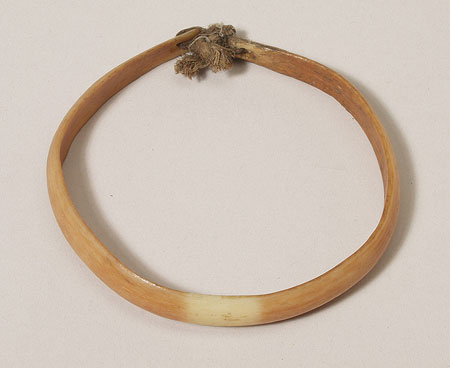Accession Number:
1917.25.83
Country:
Sudan
Region:
[Southern Sudan?] [White Nile]
Cultural Group:
Dinka
Date Made:
By 1917
Materials:
Bone , Plant Fibre
Process:
Carved , Polished , Stained , Perforated , Twisted , Tied
Dimensions:
Max L = 98.7 mm Max W = 92.2 mm Max Ht = 13.5 mm [RTS 25/3/2004].
Weight:
20.3 g
Other Owners:
Robert Grenville Gayer-Anderson, probably collected in the period immediately before World War I (1909-1914) [RTS 1/6/2004].
Field Collector:
Robert Grenville Gayer-Anderson
PRM Source:
Robert Grenville Gayer-Anderson
Acquired:
Donated 1917
Collected Date:
By 1917
Description:
Penannular armlet made from a narrow piece of bone, probably an animal rib, flat on one side and convex on the other.
This tapers slightly to either end, and has been bent into an almost circular loop with the ends 8 mm apart, and the flat surface on the inside face where the object would rest against the arm.
A hole has been bored through either end, and a piece of plant fibre string passed through them and tied off on the inside.
This string is made from two strands twisted together.
The object is complete and intact, and the surfaces have been polished.
The bone is its original yellow colour at the centre of the object (Pantone 7401C), but has been stained orange elsewhere (Pantone 157C).
The armlet measures 98.7 by 92.2 mm across its outer edges, and 91 by 84 mm across its inside edges; the bone from which it has been shaped has a width of 13.5, is 3.2 mm thick and weighs of 20.3 grams.
Collected by Robert Grenville Gayer-Anderson, probably between 1909 and 1914, in the period immediately before World War I, somewhere in the ‘White Nile’ region. Throughout the twentieth century the term ‘White Nile’ has been used to denote an administrative district immediately south of Khartoum. However at the time this object was collected the term was also used more loosely to refer to the Bahr el Abiad and Bahr el Jebel rivers, or the areas immediately around them, and association with the Dinka suggests this is probably the case here.
Rachael Sparks 17/9/2005.
Collected by Robert Grenville Gayer-Anderson, probably between 1909 and 1914, in the period immediately before World War I, somewhere in the ‘White Nile’ region. Throughout the twentieth century the term ‘White Nile’ has been used to denote an administrative district immediately south of Khartoum. However at the time this object was collected the term was also used more loosely to refer to the Bahr el Abiad and Bahr el Jebel rivers, or the areas immediately around them, and association with the Dinka suggests this is probably the case here.
Rachael Sparks 17/9/2005.
Primary Documentation:
Accession Book Entry
[VI, p.
54] - 1917 [pencil insert] 25 [end insert]
MAJOR R.G.
GAYER-ANDERSON
, R.A.M.C.
The Lodge, Old Marston, Oxon [pencil insert, p.
56] 83 [end insert] - Armlet of bone curved into a ring, Dinka, White Nile.
Additional Accession Book Entry [page opposite 54] - A gift to the Pitt Rivers Museum in memory of Major R.G. Gayer-Anderson, Pasha, his twin brother Colonel J.G. Gayer-Anderson, C.M.G., D.S.O. [page opposite 56] - 1917.25.83 No given AP [red biro] A20 F10 3.
Card Catalogue Entry - There is no further information on the tribes catalogue card [RTS 9/3/2004].
Related Documents File - Two letters dated 30/03/1917 and 13/04/1917 from the donor to Henry Balfour regarding the donation of the collection to the museum [EB 12/11/2001]. These indicate that the material was collected by Robert Gayer-Anderson himself, chiefly from the areas of Nuba, Kordofan and Bahr el Ghazal during 5 years he spent in the Sudan, and that they were given to the museum as an unconditional gift [RTS 5/12/2003]. The note in the accession book calling this gift 'in memory of' R.G. Gayer-Anderson is therefore somewhat enigmatic, as both Robert and his twin brother (Thomas G., not J.G.) were alive at the time of the transfer [RTS 5/12/2003].
Pitt Rivers Museum label - AFRICA, SUDAN DINKA penannular bone armlet Donated by Major R.G. Gayer-Anderson 1917 1917.25.83 [LM 'DCF 2004-2006 What's Upstairs?' 12/10/2005]
Written on object - DINKA bone armlet WHITE NILE. d.d. Major R.G. Gayer-Anderson, 1917 [RTS 17/3/2004].
Additional Accession Book Entry [page opposite 54] - A gift to the Pitt Rivers Museum in memory of Major R.G. Gayer-Anderson, Pasha, his twin brother Colonel J.G. Gayer-Anderson, C.M.G., D.S.O. [page opposite 56] - 1917.25.83 No given AP [red biro] A20 F10 3.
Card Catalogue Entry - There is no further information on the tribes catalogue card [RTS 9/3/2004].
Related Documents File - Two letters dated 30/03/1917 and 13/04/1917 from the donor to Henry Balfour regarding the donation of the collection to the museum [EB 12/11/2001]. These indicate that the material was collected by Robert Gayer-Anderson himself, chiefly from the areas of Nuba, Kordofan and Bahr el Ghazal during 5 years he spent in the Sudan, and that they were given to the museum as an unconditional gift [RTS 5/12/2003]. The note in the accession book calling this gift 'in memory of' R.G. Gayer-Anderson is therefore somewhat enigmatic, as both Robert and his twin brother (Thomas G., not J.G.) were alive at the time of the transfer [RTS 5/12/2003].
Pitt Rivers Museum label - AFRICA, SUDAN DINKA penannular bone armlet Donated by Major R.G. Gayer-Anderson 1917 1917.25.83 [LM 'DCF 2004-2006 What's Upstairs?' 12/10/2005]
Written on object - DINKA bone armlet WHITE NILE. d.d. Major R.G. Gayer-Anderson, 1917 [RTS 17/3/2004].



